The Sichuan pepper tree is a shrub that bears the delicious Sichuan pepper.
Sichuan pepper facts
Name – Zanthoxylum species
Family – Rutaceae (Rue family)
Type – shrub
Use – standalone, garden box
Height – 6 to 17 feet (2 to 5 m)
Exposure – full sun
Foliage – deciduous – Flowering – Spring – Harvest – Fall
Easy to grow, it does very well in our temperate climates.
Planting the Sichuan pepper tree
It is best to plant Sichuan pepper trees in spring or in fall.
If purchased in a pot or in a container, Sichuan pepper tree can also be planted anytime during the year while avoiding frost spells and de high temperatures.
Even though Zanthoxylum piperitum or Sichuan pepper tree is very tolerant as to the type of soil it is given, try to avoid waterlogged soil.
- Adding fertilizer upon planting at the bottom of the hole helps increase rooting, regrowth and development of the Sichuan pepper tree.
- Follow our shrub planting guidelines.
Potted Sichuan pepper tree
This is a shrub that is perfectly suited to growing in pots or garden boxes, as long as you’re ready to repot it every 2 or 3 years.
- Double-check that the bottom of the pot has a hole in it.
- Place a bit of gravel or clay beads at the bottom to increase drainage.
- Fill in the pot or garden box with citrus-specific soil mix.
- Don’t keep the pot in a deep pot-holder that might fill up with water.
Sichuan pepper tree orchard
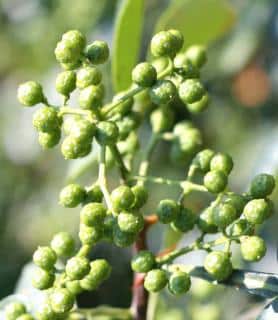
- More vigorous Zanthoxylum piperitum and Zanthoxylum simulans can be planted in rows spaced 18 feet apart, with 18 feet between trees (6 x 6 meters).
- Smaller Z. armatum and Z. schinifolium can be planted in rows and lines spaced 12 feet apart (4 x 4 meters).
- This can be adjusted somewhat depending on rootstock, climate, and pruning practices.
When growing them in an orchard, the goal is to make harvesting easier. As for olive trees and citrus trees, prune to keep them short. This makes hand-picking easy.
A diamond pattern will let the trees spread a bit more than the basic square pattern.
Propagating the Sichuan pepper tree
Sowing Sichuan peppercorn seeds
Best is to sow Sichuan pepper seeds in fall, when the pepper is harvested.
You can also start sowing your Sichuan pepper seeds in spring, after having kept the seeds in the cold for a while.
- Sichuan pepper seeds germinate best when they’ve gone through a period of colder, near-freezing weather.
- Place them in a dry pouch or paper towel in the refrigerator for at least a month.
Sichuan pepper plant cuttings
Prepare Sichuan pepper tree cuttings on semi-hardened wood.
Sample 6-inch (15 cm) cuttings from July to September, on semi-hardened wood (not yet hard, still bends easily).
- Remove lower pairs of leaves, keeping only one or two pair(s) at the tip.
- If possible, dip the base of the cuttings in powdered rooting hormones.
- Plant the cuttings in special cutting soil mix and keep cuttings near light, but not in direct sunlight.
- Keep the substrate a little moist and water less in winter.
- Protect your cuttings in winter, bringing them in a cool spot but keeping them out of the cold. Ideal temperatures range from 40°F to 50°F (5°C to 10°C).
Read also: how to prepare shrub cuttings
Sichuan pepper, a dioecious plant
Note that the Sichuan pepper plant is mostly dioecious, meaning male and female trees are different.
- The spice hulls come from the female trees. Male tree flowers can also be used as a spice, with similar taste. They don’t keep as well, though. Note that this isn’t the same thing as the edible Sichuan flower buds (or szechuan buzz buds): those yellow buds come from a completely different plant.
- Some varieties, cultivars and species aren’t strictly dioecious. They may be self-fertilizing, having both male and female flowers. Some males will bear a few berries.
- Check with your seedling provider to make sure yours will pollinate successfully.
- Bees and other pollinator insects will greatly increase productivity.
Caring for Sichuan pepper tree
This is a tree that doesn’t call for much care, but you can still increase its growth with a few good tips to favor a great Sichuan pepper harvest.
Considered hardy and resisting temperatures as low as 5°F (-15°C), it is a plant that readily makes do with the poorest soils.
However, it is important to water in case of high temperatures or prolonged dry spells.
- This is particularly true for pot-grown Sichuan pepper trees.
Diseases and pests occasionally found on Sichuan pepper
Usually Sichuan pepper resists diseases well. However, some diseases have been known to infect the plant:
- Pepper tree leaf blotch – Septoria pachyspora, a fungal disease that spots leaves.
- Fusarium wilt – leaves wilt away
- Alternaria – like Septoria, spots appear on leaves.
Not so vulnerable to parasites or pests, but sometimes invaded by aphids.
- Here is how to fight aphids off
Pruning the Sichuan pepper tree
Whether as a standalone, in a hedge or in a flower bed, it doesn’t really require any particular pruning.
But it is often nice to succeed in giving it a nice shape, especially when it is part of a hedge.
- Pruning is tolerated in spring or winter, as long as it doesn’t freeze of course.
- Never prune new growth, because that is what will bear the pepper.
- So best is to chop off any wood that grows towards the inside. This frees up the center part of the pepper tree and lets the sun penetrate deep inside.
- Remove weak or dead branches.
For potted Sichuan pepper trees, plan to have more drastic pruning to restrict its growth, and help it stay in the pot for a bit longer.
In Sichuan pepper tree orchards, pruning aims to keep the tree short. Harvesting the peppercorns is easier on short trees.
Harvesting Sichuan pepper
The harvest takes place at the end of the summer and at the beginning of fall, in general towards September-October.
That is when hard, little marbles appear, covered with a thin pink husk. This thin pink hull is the actual pepper we eat, not the seed-marble at all.
Place a tarpaulin or a bedsheet under the pepper tree and shake the trunk and branches to make the Sichuan pepper fall off.
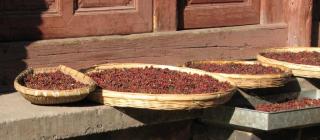
Unlike conventional pepper, the inside seed isn’t edible.
This plant is part of same family as the orange tree and lemon tree. Indeed, both Zanthoxylum and Citrus genus belong to the Rutaceae family. This explains the citrus-like flavor of the spice.
Sichuan pepper varieties
Sichuan pepper is a general term that includes several different species of the Zanthoxylum family. Another spelling for “Sichuan” is “Szechuan”.
- Zanthoxylum piperitum is the most common species, often sold in horticulture stores. Dioecious. Other names for this species include sansho and Japanese pepper, as well as Korean pepper. It is native to Japan and to parts of mainland China.
- Zanthoxylum simulans is also easy to find. Dioecious. Also called Chinese pepper. One of the tallest growing species, topping off at 20 feet (7 meters). Synonyms are Zanthoxylum bungei and Zanthoxylum bungeanum.
- Zanthoxylum armatum – Common name is green Sichuan pepper. Self-pollinating but more productive if several trees cross-pollinate. Much harder to find for planting. Semi-wild Sichuan pepper variety grown in remote parts of Asia, among others in Bhutan. Also called wild peppercorn and Nepal pepper. Rarity and labor-intensive harvesting have increased costs. Distinctive taste.
- Zanthoxylum schinifolium – also named wild zanthoxylum or mastic-leaf prickly ash. Dioecious.
Other plants of the same genus don’t qualify as “Sichuan pepper” since they’re not specifically from Asia. But they’re very similar and share the same uses: spice, medicinal, and ornamental.
- Zanthoxylum americanum – native to North America, around the Great Lakes and the Mississippi watershed. Dioecious. Common name prickly-ash. It’s the type species for the Zanthoxylum genus.
In garden stores, new ornamental varieties appear:
- Zanthoxylum piperitum ‘Black Magic’ – Leaves are a deep purple sheen, very dark color. Perfect for starting an intriguing black garden!
Sichuan pepper plant regulation
- Details on regulations regarding Sichuan pepper
Sichuan pepper is a plant that is closely related to the citrus family. One disease that typically infects the Sichuan pepper tree is a particularly strong strain of citrus canker, Xanthomonas citri. It is a bacteria that is highly damaging to the entire citrus family. Entire orchards could be wiped out in a few years.
- Currently, this particular canker only infects trees and plants in the Sichuan pepper tree’s native environment.
- A few other places are already infected.
- In the United States, no cases have yet been observed.
There are no known means to cure a tree from this disease. The only way forward is prevention.
- Individual trees and orchards can be protected with Bordeaux mixture or other copper-based products.
- Any infected individual will not heal. At most, disease spread is slowed.
That’s why the ultimate solution is simply to keep the bacteria out of the territory, hence the sichuan pepper import ban.
- If you read the article linked right above you’ll discover the good news: with a special treatment for seeds and a screening of where the seeds come from, you can still plant Sichuan pepper at home!
Learn more about the Sichuan pepper plant
This is a plant that is native to the Chinese province of Sichuan, (or, again, “Szechuan”). It can cope with hardy, cold winters and loves full sun.
The long, narrow leaves dangle down in a cascading effect almost as intense as that of the weeping willow.
In this, it lends a distinctive Asian touch to any garden. Sichuan peppercorn complements other plants that have a similar impact such as the Mahonia ‘Soft Caress’ (incidentally native to the same region!) and, of course, a variety of bamboo species.
Smart tip about Sichuan pepper
Take care to wear gloves for the harvest, because Sichuan pepper tree branches have spikes and thorns! Carpenter’s gloves will keep most of the prickly thorns out, while still staying flexible enough to make the harvest easy.
CC BY 2.0: rduta
CC BY-SA 2.0: Matthieu Lelievre

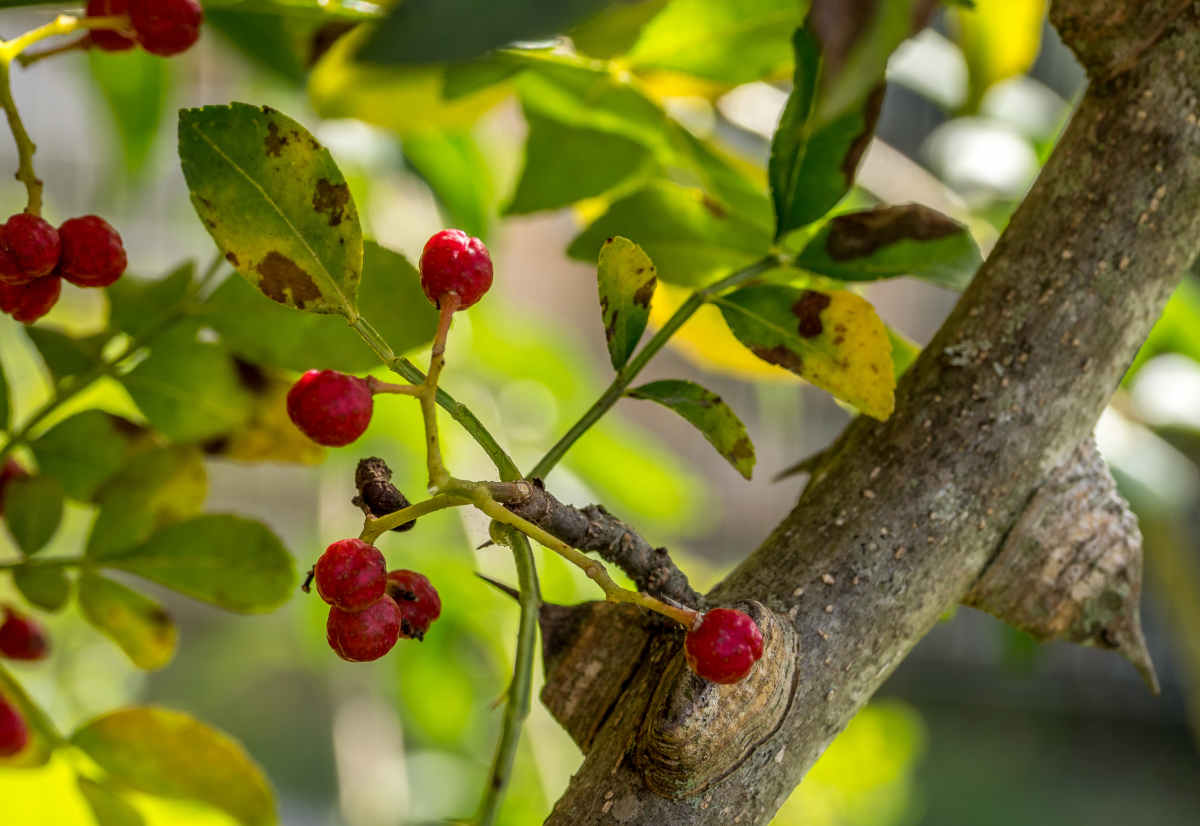
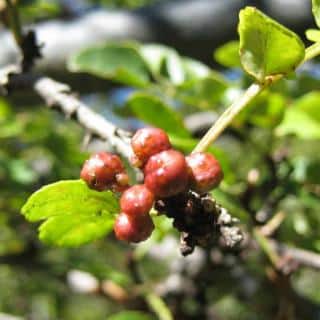


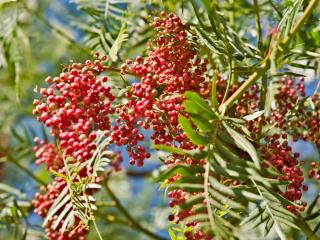
Are two Szechuan pepper plants needed to pollinate? A male and female?
Hi Marion, it depends on the species. The most common on, Zanthoxylum piperitum, is dioecious. This means a male tree must be near a female tree for it to pollinate, so yes, both are needed. The only species that can partially self-pollinate is Zanthoxylum armatum, the green szechuan pepper.
I planted a little twig( Sichuan pepper plant) about 18 months ago and now it is 1.5m high and 3m across but have no idea whether it is male or female or what variety it is. I bought in on the internet from britain but I can’t remember from whom. Is there any way to identify the variety and sex? I had several berries last year and this year there are several bunches. I was also troubled by the the problem with canker as I also have a Kaffir Lime and a Curry leaf shrub which I believe is also related to the citrus family. South Vendee, France
Hi! It seems to be growing very well! By your description, it seems it is probably “mostly female”, since it’s actually producing multiple clusters of berries. The species isn’t strictly dioecious so there’s often a mix of both flowers on the same tree. To ID it, it’s important to take good pictures of the tree as a whole, zoom in on the flowers (male and female if possible), berries, thorns, bark, leaves (topside and underside)… The more, the better! No need to worry about the canker: if you purchased the plant through the UK, they normally vetted it through customs properly and probably even started the seedlings themselves from healthy, treated seeds. Pas de problème pour le citron et le curry! 🙂
Hello
I was wondering if anyone knew about any books regarding Sichuan pepper
Thank you
That’s a good question and from my own research, for planting, there isn’t. I do hope to stand corrected about this! Perhaps a more astute reader can help us.
However, there are several books that describe or compile recipes for which the sichuan/szechuan pepper is an ingredient. There is certainly more literature in chinese, but that is one language I don’t yet command…
Dear Sir,
I am interested to know the plant to plant and row to row distance for a good orchard of Sichuan pepper.
Hello Basu, it depends on the species, type of pruning, and the growing environment.
If you already have a few Sichuan pepper trees growing nearby, observe them closely to estimate what distance is best in your conditions. For example, vigorous varieties in a good growing place can grow to 18 feet across (6 meters) or even 21 (7 meters).
Once you’ve determined the best spacing, remember to keep a space for tractors or vehicles every few rows, if you plan to use them. And check with your supplier what the best ratio for female to male plants you need, too!
I understand the whole species is banned in the USA because of a risk that they can carry canker that attacks other tree of the citrus family. Only heat-treated non-viable seeds are allowed.
Hi Meic, it’s actually not a complete ban. Seeds can be imported for planting as long as they’re submitted to a heat and chemical treatment. The information is buried quite deep in regulation papers, though…
Thanks for your comment, it helped me clarify the question for myself and hopefully other readers, too!
Thanks Gaspard. I now realise my information was a bit out of date. A session of websearching suggests there are now several sources of Sichuan pepper plants in the USA, though whether any source specifically Bhutan seeds, I don’t know. I wish him luck.
Meanwhile, the two I planted last year in my garden in Sussex (England) are flourishing, and I hope don’t transmit anything nasty to the Makrut lime I’m about to plant.
All the best
Makrut lime? Wow! You’ve got a really exotic garden!
Where can I buy Sichuan pepper saplings (prefer the type that grows in Bhutan) in USA? Type that grows in Bhutan has strong flavor and better taste.
It’s true that the Bhutan variety is famous for tasting even better! I added a section to the article to explain how it might be possible to get seeds from Bhutan to grow your own sichuan pepper!